This is a complete guide on how to make and bake pizza in oven, including several darn good pizza recipes. You’ll see all the steps with tips and techniques for a successful homemade darn good pizza. This is a part of our Food Guides, Pizzas, Italian Cuisine, Ham, Game Day, Holidays, Thanksgiving, & Christmas categories.
Step 1. Pick a Pizza Recipe
Choose a recipe on which homemade one you’ll make
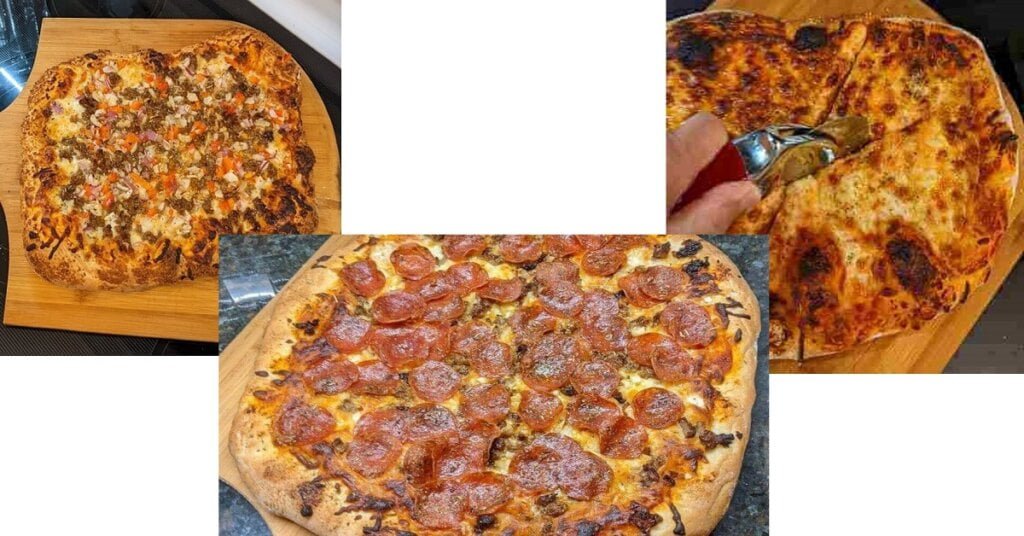
Choose a pizza recipe and get those ingredients. These are all homemade for the oven. Also, they’re all a great tie-in with this guide.
Recipes for Homemade Pizzas In Oven
- Cheese Pizza
- Sausage Pizza
- Pepperoni Pizza
- Sausage and Pepperoni Pizza
- Half Pepperoni Half Sausage Pizza
- Supreme Pizza
- Homemade Pizza in a Cast Iron Skillet
- Chicken Pizza
Step 2. Make The Pizza Dough
Now that you’ve chosen which recipe you’re going to make, it’s time to make the dough as your base. So, decide which of these two popular ways you choose to follow and make it.
- Make Pizza dough homemade by hand
- Make Pizza dough using a bread machine (using the “dough” cycle)

Lay the pizza dough out onto a floured surface
Then, using your hands and/or a rolling pin, stretch and roll it out. I described this in detail in my dough recipes:
Stretch and roll out your dough to the shape of your intended bakeware
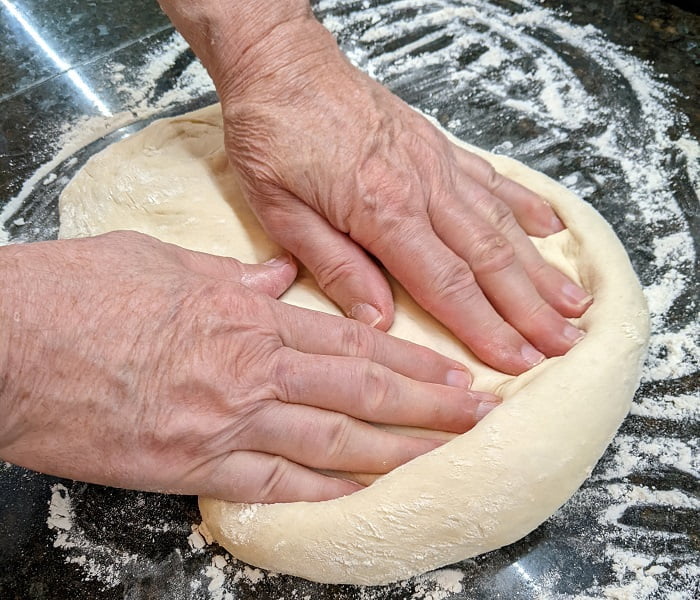
You’ll want to make it the approximate shape of the bakeware you’re going to use. Then, You can go to the next section of adding the sauce.
Step 3. Choose a Pizza Sauce and Spread It on Dough.
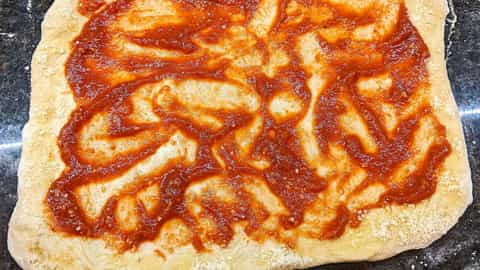
It can be pizza sauce, spaghetti sauce, marinara, or tomato sauce
We’ve tried about a dozen types over the years and below is the list we’ve used and accepted. However, our 1st choice was Ragu Spaghetti Sauce and our 2nd choice was Bertolli Marinara Sauce. Just spoon it over the top of your dough base.
- Pizza Sauces (like Chef Boyardee Pizza Sauce, Prego Pizza Sauce, Ragu Pizza Sauce, or Rao’s Pizza Sauce)
- Tomato Sauce (just sprinkle 1/2 tsp Oregano or Italian Seasonings on it after spreading it)
- Spaghetti Sauce (like Ragu Traditional Spaghetti Sauce)
- Marinara or related sauces (Bertolli, Classico, or others)
Step 4. Add the Toppings
Now, you’ll add the toppings in order, following your recipe’s recommendations. These toppings will be cheeses, meats, veggies, and spices. So, keep reading for familiarity with all kinds of options for building different kinds of pizzas.
Meats for Toppings
Popular Meat Toppings: Sausage, Pepperoni, Ham, & Salami
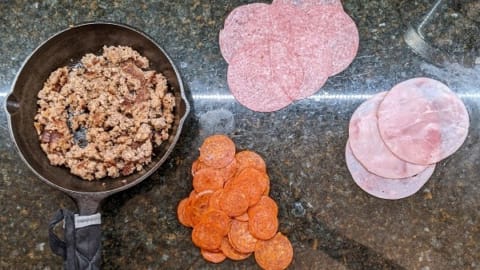
So, if you are going to build a pizza including meat, you have a lot of options. Sometimes, you might want to combine 2 meats. But, other times you might want to keep them each on their half side.
A supreme pizza usually has 3 or more meats. So, here’s our list of meats great for pizzas.
- Pepperoni (including Turkey Pepperoni)
- Sausage (Pork Sausage, Italian Sausage, or Turkey Sausage)
- Ground Beef
- Ground Beef and Ground Pork
- Bacon
- Sausage and Pepperoni
- Half Pepperoni and Half Sausage
- Ham or Leftover Ham
- Salami
- Pepperoni, Sausage, and Ham
- Pepperoni, Sausage, Salami, and Ham
- Chicken
- Ground Chicken
- Steak
Cheeses for Pizza

More than one kind of Cheese can be added as Toppings
Which cheese is best for homemade pizzas oven baked? The safest bet is always Mozzarella as the primary cheese for pizza. For adding a second cheese, Parmesan is a good choice. Finally, here are the cheeses that many people will have for pizzas, in order of preference.
- Mozzarella
- Parmesan
- Romano
- Provolone
- Asiago
Swiss Cheese is also a good one; however, it has a sharp, unique flavor that not everyone appreciates. However, it pairs real good with ham primarily.
Feta cheese is seen sometimes on Greek or Mediterranean related themes.
Goat cheese is sometimes found on specialty or Artisan pizzas. To see more about cheeses on pizzas, look over the Homemade Cheese Pizza recipe.
Fresh Veggies for Toppings
Veggie Toppings and an Extra Cheese, Prepped and Measured
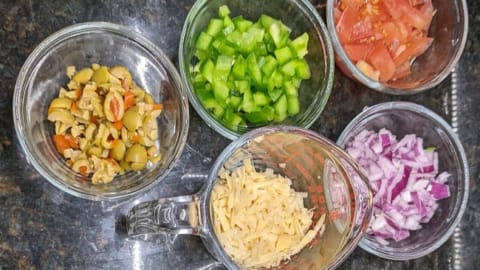
Vegetable toppings are where everyone has the most fun. Balance the cheeses and meats with certain kinds of vegetables. Or, go with an all vegan pizza. Regardless, nearly all pizzas have at least one vegetable and most will have two or three.
With that said, here’s a popular list of vegetable toppings that everyone chooses from.
- onions (sweet, yellow, Spanish, or red/purple)
- bell peppers (green or other colors)
- tomatoes
- black olives
- mushrooms
- spinach leaves
A good example of using a lot of those popular veggies is the Supreme Pizza. So, specialty vegetable toppings are listed here.
- green olives
- avocados
- grape tomatoes
- red, orange, or yellow bell peppers
These veggie toppings are usually prepared in the following ways:
- diced or chopped
- sliced
- strips
- halved
- chunky
- whole
Fruits for Toppings
Yes, there are even fruits on certain specialty pizzas. So, the most common is probably the Ham and Pineapple for a Hawaiian style pizza. Regardless, just having some pineapple bits with ham as the dominant meat is a great flavored dish.
For a little added extra taste and presentation, put a small amount of whole or halved sweet red cherries on top. Also, some have called for adding raisins. Finally, there can also be dessert themed pizzas that will have more types of fruits and nuts added.
Spices
Add Small Amount of Spices Before You Bake Pizza in Oven
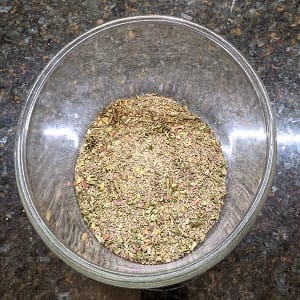
There are a number of options for additives, supplements, spices, and herbs that can go into making a tremendous product before you bake pizza in oven. Most recipes will have spices to add like Oregano or Italian Seasonings.
Some specialty or gourmet pizzas might even call for things like shredded coconut or nuts of various types. Also, others might call for sometimes adding condiments like brown mustard or barbecue sauce.
Step 5. Transfer To Bake Pizza In Oven
Now you transfer your prepared pizza from the countertop to the oven. Here are some different scenarios of how this happens.
- It was built on a pizza pan or baking sheet and it’s put into the oven easily.
- It was built in a cast iron skillet and it’s then put into the oven.
- There’s a hot pizza stone or pizza steel (aka “baking steel”) in the oven. Depending what the pizza was built on, it then goes into the oven in one of the following ways.
- The pizza was built on a pizza peel so you use the peel to slide it onto the hot stone or steel in the oven.
- The pizza was built on the countertop so you can use a metal pizza peel to scoop it up and put it onto the hot stone or steel in the oven.
For more details on transferring the prepared pizza from the countertop to bake it in the oven, read our article that discusses how to use a pizza peel.
Transfer and Bake Pizza in Oven
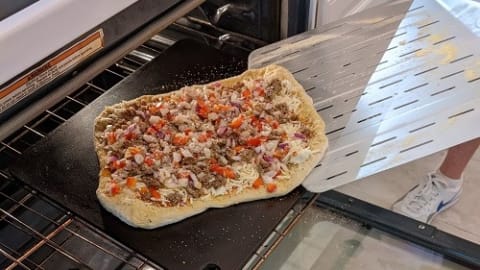
If not using a pizza peel, it’s recommended to stay with baking methods using a baking sheet, pizza pan, or skillet. You can build directly on that kind of bakeware as it won’t require a transfer.
Step 6. Bake Pizza In Oven: Temps & Times
To bake pizza in ovens, the bakeware you use determines oven temps and times. We’ll now cover both of those and how it changes using different bakeware such as skillets, pizza pans, baking sheets, stones, and steels.
Pizzello.com also has some great tips for baking pizza in the oven. And they make pizza ovens too.
Temp to Bake Pizza in Oven
Knowing your recipe’s temp to bake it in the oven is crucial. Fortunately, most recipes use oven temps like 450⁰F to 500⁰F, and these are commonly available in kitchen ovens.
- Par-baking pizza crust, with no toppings, is often about 450⁰F.
- Baking homemade pizzas in regular kitchen ovens are often about 500⁰F but some recipes will call for less than that. The only temps that are higher than this are for specialty pizza ovens that call for as high as 700-850⁰F.
Cooking Time To Bake Pizza In Oven
Time durations to oven bake pizzas that don’t have much toppings will have much shorter cooking times. For example, a thin crust cheese pizza with no veggies uses a much shorter bake time.
However, pizzas that have a lot of toppings like 2 meats, 3 cheeses, 2 veggies, will have much longer times. Also, times are very dependent on bakeware used too. Types of bakeware are iron skillets, pans, baking sheets, stones, and steels.
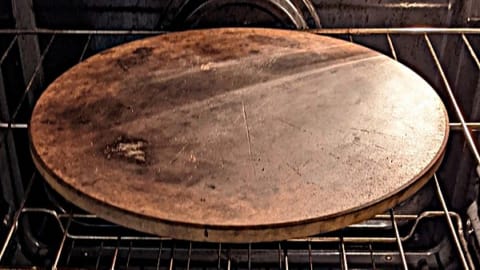
Pizza Stone Preheating in Oven
List of Temps & Times To Bake Pizza In Ovens
Below is an overall list of homemade pizza temps & times to bake pizza in ovens. Temp and time will vary mostly on these 3 things:
- thickness and size of the dough
- amount and kinds of toppings
- bakeware used (highest impact)
Bakeware use has the biggest impact. So, here’s a range of some of those values.
- Skillet 14-28 minutes at 450⁰F.
- 6-inch: 14-18 minutes
- 10-inch: 18-23 minutes
- 12-inch: 20-25 minutes
- 14-inch: 22-26 minutes
- 16-inch: 22-28 minutes
- Baking Sheet or Pizza Pan at 450⁰F: 21-23 minutes
- Pizza Stone at 500⁰F: 16-20 minutes
- Baking Steel (¼-inch) at 500⁰F: 12-16 minutes
Step 7. After You Bake in Oven, Slice It and Serve
Cut your perfect pizza and serve it

So, after your pizza has been baked, remove it from the oven and let it rest about 5-10 minutes. Then, cut it for serving.
Pro Pizza Cutting TIP: A good easy method of cutting with any pizza cutter is to start from the center and go to the outer crust edge.
Step 8. Popular Sides to Serve with Pizza
Here are some popular sides that go with this Italian food. A simple green lettuce salad or spinach salad are super and healthy sides. Or, even celery and carrot sticks are good crunchy things to munch on. However, read our article “Sides With Pizza: The Best Pizza Sides To Serve” to see a more complete ideas list.
Step 9. Storing Pizza Leftovers
What to do with leftover pizza

So, after enjoying your homemade pizza, you’ll want to store any leftovers, if you have any. Next, there is some important information for storing it. It’s a good section to review for consideration of food safety and quality control.
How To Store Pizza
While you can store pizza in a plastic food container, it might keep better if you can have it exposed to less air by using a plastic food storage bag or plastic wrap.
To keep leftover pizza even longer, I will wrap the pizza in food plastic wrap and then bag it for the freezer. While I’ve gone as long as 3 months, I think the quality is retained best for a maximum of 1 month after freezing.
How Long Leftover Pizza Shelf Life
I will be able to keep leftover pizza safely in the fridge for about 3 days. However, I never go past 5 days. Also, if I’ve left a freshly cooked pizza out on the counter for over an hour, I typically won’t keep it past 2 days in the fridge.
For food safety, you generally don’t want to leave your cooked pizza out on the serving space beyond about 1/2 hour. However, there are some exceptions. One example is if it’s left on the hot bakeware that retains heat. Cast iron skillets or cast iron pizza pans hold their heat longer than most. While differing scenarios might not show any visible signs of difference, behind the scenes, bacteria levels are accelerated the longer the cooked pizza is left out at room temperature.
Reheating Leftover Pizza
Prepping Leftover Pizza Slices to Reheat in Oven

There are numerous ways to reheat this leftover, popular Italian food. Many have difficulty with maintaining the texture and flavor of reheated pizza so, here are some solutions. Also, these are listed in order of frequency that people use.
- Microwave: Reheat Pizza in the Microwave
- Oven: Reheat Pizza in the Oven
- Skillet or Pan: Reheat Pizza in a Skillet or Frying Pan
- Air Fryer: Reheat Pizza in Air Fryer
First off, if the pizza was frozen, it needs to be thawed out before any reheating. One way is to put it in the fridge overnight. However, most people, myself included, won’t plan for that in advance so, you can use the microwave to defrost it but not to get it fully reheated just yet.
Reheat pizza microwave time
If you reheat in the microwave, on full power, one slice can take about 30-90 seconds, depending on wattage. The level of crispiness will be lowest when reheating in the microwave and far better with other methods
So, if you use a microwave’s “Reheat” option, you can consider using it and tweaking it for your individual unit. It will taste better if it’s not a direct full power heating. Also, sometimes I’ll wrap the slices in paper towels but it won’t be as crispy.
Times & Temperature for reheating pizza in the oven
For fastest time, use a baking sheet in the oven at 400°F to reheat pizza. Generally, you don’t want to go hotter. If you choose to reheat in the oven, here’s a real good complete method. So, see our complete article “How to Reheat Pizza in an Oven: Expert Ways“.
How to reheat pizza in a pan or skillet
The fastest good tasting method is in a skillet or frying pan that has a lid or cover. The only limitation is the number of slices you can heat up at once. This might be 2-3 slices depending on the pan size and the size of the slices. Here are the details of several ways to “Reheat Pizza in a Skillet“.
How long reheat pizza in air fryer
Air fry them for about 4-6 minutes but, it depends on your Air Fryer. Real thick slices might need a little longer. However, like the frying pan, the amount of slices is limited; you don’t want to stack these. So, set the air fryer for French Fries (about 390°F) for about a minute. Then, add in the slices for a single layer only. Also, to prevent drying out, you can wet your fingers in water and “flick” them to sprinkle it across the slices’ tops.
Tools To Make & Bake Pizza In Oven Easier
In the process of making and baking pizzas, you will come across some specialty tools that will make your job a lot easier.
Homemade Pizza Tools You’ll Want
- Tools for transferring them from the counter to the oven, and again for removal from the oven.
- Cutting tools for slicing
- Surfaces for cutting and serving
- Turning tools for turning the baking product around inside deep, extreme heat ovens.
- Pumice Stone Cleaning Brick (used for deep cleaning the Baking Steel; see “How To Clean Pizza Steel“)
Homemade Pizza Cutting Surfaces
You’ll need an adequate cutting surface and a cutter. Regarding the cutting surface, you can use a large cutting board. However, many homes don’t have a large enough cutting board for a 12 to 16-inch sized Italian pie. So, if you can cut on the countertop, you’re good to go. If you can’t, the solution might be to get a wooden pizza peel but a somewhat thick one as the thinner ones aren’t recommended for cutting on.
The wooden pizza peel is good for both transferring, serving, and sometimes for cutting. And, if you read the pizza peel article, you can also use it for building on it so you only have to slip it into the oven.
Pizza Cutters for After you Bake Pizza in Oven
Regarding the actual cutting tool, there are a lot of choices. These can basically fall into 2 types: wheel or rocker.
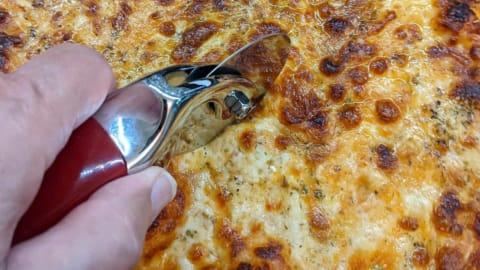
Use a Pizza Wheel Cutter Starting from the Center to the Edge
The Pizza Wheel Cutter
The wheel cutter is the most commonly used in homes and takes up a small amount of space. You can look around and even get one at the grocery store. But, we finally found one that is extremely heavy duty, solid, and has never rusted in the dish washer after several years and 200 pizzas later. Although, it’s a bit pricey compared to others.
The Pizza Rocker Cutter
The rocker cutter is a little easier to use but takes up a lot more space. Also, it’s like the kind that restaurants use. So, if you get one, you’ll want to ensure it’s the length of your potentially largest pizza you’ll ever make.
Pizza Peel for Transferring Pizzas
If you make pizzas about 6 times a year, you’ll want a great transfer tool, i.e., a “pizza peel”). Also, if your bakeware itself is preheated to a very high temperature, a pizza peel is required. In that scenario, you’ll need to safely transfer the prepared uncooked pizza from your work area onto the extremely hot bakeware. Also, when it’s baked, you’ll need it again to remove it from the hot bakeware in the oven to transfer it to the cutting area.
So, here’s an article of how to use the pizza peel to give you a better idea of its usage.
Selecting A Pizza Peel For Transferring To Bake Pizza In Oven
How do you know what kind of pizza peel to get? They have some that are metal and some that are wooden. Some you can also use to cut pizzas on. Basically, you’ll want a very thin pizza peel to scoop it up from the counter without scrunching it all up (since it’s base is still raw dough). You’ll then need to “slip” it off the peel onto the hot bakeware in the oven.
Conclusion of Make & Bake Pizza In Oven
This is your complete guide to make and bake pizza in an oven. So, you can refer to it in the future. Also, you’ve read easier ways of making pizzas using appropriate tools for transferring pizzas to & from ovens, as well as slicing on them for serving.
We even covered storing leftovers and reheating pizza to a much better level of enjoyment. Now, plan your next pizza easier and faster. So, make that dough in advance and store it in the fridge or freezer. Then, plan it to make darn good pizzas at home!
Related To Homemade Pizza Baking
- Best Pizza Peels by Purpose, Material, & Surface
- How To Use A Pizza Peel
- How To Make & Bake Pizza in Oven – Several Recipes (this post)
- How To Clean Pizza Steels
- Cast Iron Pizzas – Complete Guide
- Reheating Pizzas


2 comments
Colier1361
Amazingly extensive for making pizzas at home. Glad you had links to more detailed items you also covered.
Vision Premium
Pretty! This has been a really wonderful post. Many thanks for providing these details.